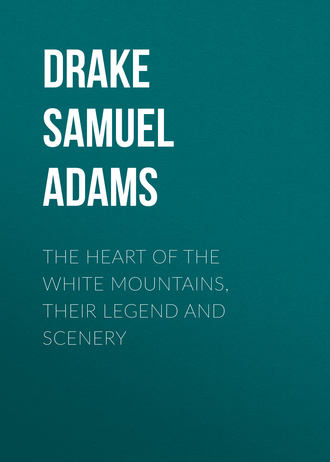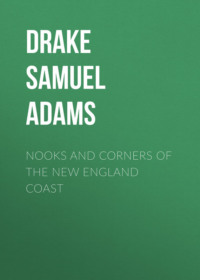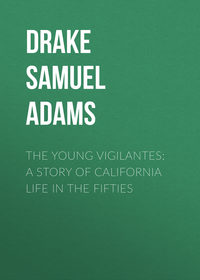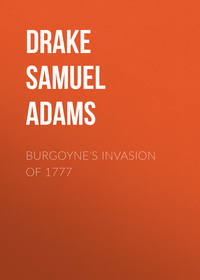 полная версия
полная версияПолная версия
The Heart of the White Mountains, Their Legend and Scenery
I have said that twenty-three men continued the fight after the bloody repulse in which Lovewell was killed. There were only twenty-two. The other, whose name the reader will excuse me from mentioning, fled from the field and gained the fort, where he spread the report that Lovewell was cut to pieces, himself being the sole survivor. This intelligence, striking terror, decided the little garrison to abandon the fort, which was immediately done, and in haste.
This was the crowning misfortune of the expedition. The rangers now became a band of panic-stricken fugitives. After incredible hardships, less than twenty starving, emaciated, and footsore men, half of them badly wounded, straggled into the nearest English settlements.
The loss of the Indians could only be guessed; but the battle led to the immediate abandonment of their village, from which so many war-parties had formerly harassed the English. Paugus, the savage wolf, the implacable foe of the whites, was dead. His tribe forsook the graves of their fathers, nor rested until they had put many long leagues between them and their pursuers. For them the advance of the English was the Juggernaut under whose wheels their race was doomed to perish from the face of the earth.
V.
NORTH CONWAY
“Tall spire from which the sound of cheerful bellsJust undulates upon the listening ear,Groves, heaths, and smoking villages remote.”THE entrance to North Conway is, without doubt, the most beautiful and imposing introduction to the high mountains.
Although the traveller has for fifty miles skirted the outlying ranges, catching quick-shifting glimpses of the great summits, yet, when at last the train swings round the foot of the Moat range into the Saco Valley, so complete is the transition, so charming the picture, that not even the most apathetic can repress a movement of surprise and admiration. This is the moment when every one feels the inadequacy of his own conceptions.
Nature has formed here a vast antechamber, into which you are ushered through a gate-way of mountains upon the numerous inner courts, galleries, and cloisters of her most secluded retreats. Here the mountains fall back before the impetuous flood of the Saco, which comes pouring down from the summit of the great Notch, white, and panting with the haste of its flight. Here the river gives rendezvous to several of its larger affluents – the East Branch, the Ellis, the Swift – and, like an army taking the field, their united streams, sweeping grandly around the foot of the last mountain range, emerge into the open country. Here the valley, contracted at its extremity between the gentle slope of Kearsarge and the abrupt declivities of Moat, encloses an ellipse of verdant and fertile land ravishing to behold, skirted on one side by thick woods, behind which precipices a thousand feet high rise black and threatening, overlooked on the other by a high terrace, along which the village is built. It is the inferior summit of Kearsarge, which descends by a long, regular slope to the intervale at its upper end, while a secondary ridge of the Moats, advancing on the opposite side, drops into it by a precipice. The superb silver-gray crest of Kearsarge is seen rising in a regular pyramid behind the right shoulder of its lower summit. Ordinarily the house perched on the top is seen as distinctly as those in the village. It is the last in the village.
Looking up through this verdant mountain park, at a distance of twenty miles, the imposing masses of the great summits seem scaling the skies. Then, heavily massed on the right, comes the Carter range, divided by the cup-shaped dip of the Carter Notch; then the truncated cone of Double-Head; and then, with outworks firmly planted in the valley, the glittering pinnacle of Kearsarge. The mountain in front of you, looking up the village street, is Thorn Mountain, on the other side of which is Jackson, and the way up the Ellis Valley to the Pinkham Notch, the Glen House, Gorham, and the Androscoggin.
The traveller, who is ushered upon this splendid scene with the rapidity of steam, perceives that he is at last among real mountains, and quickly yields to the indefinable charm which from this moment surrounds and holds him a willing captive.
Looking across the meadow from the village street, the eye is stopped by an isolated ridge of bare, overhanging precipices. It is thrust out into the valley from Moat Mountain, of which it forms a part, presenting two singular, regularly arched cliffs, seven hundred to nine hundred and fifty feet in height toward the village. The green forest underneath contrasts vividly with the lustrous black of these precipitous walls, which glisten brightly in the sunshine, where they are wet by tiny streams flowing down. On the nearest of these is a very curious resemblance to the head and shoulders of a horse in the act of rearing, occasioned by a white incrustation on the face of the cliff. This accident gives to it the name of White Horse Ledge. All marriageable ladies, maiden or widow, run out to look at it, in consequence of the belief current in New England that if, after seeing a white horse, you count a hundred, the first gentleman you meet will be your future husband! Underneath this cliff a charming little lake lies hid.
Next beyond is the Cathedral Ledge, so called from the curious rock cavity it contains; and still farther up the valley is Humphrey’s Ledge, one of the finest rock-studies of them all when we stand underneath it. But the reader now has a general acquaintance with North Conway, and with its topography. He begins his study of mountain beauty in a spirit of loving enthusiasm, which leads him on and on to the ripeness of an education achieved by simply throwing himself upon the bosom of indulgent Nature, putting the world as far as possible behind him.
But now from these masses of hard rock let us turn once more to the valley, where the rich intervales spread an exhaustless feast for the eye. If autumn be the season, the vase-like elms, the stacks of yellow corn, the golden pumpkins looking like enormous oranges, the floor-cloth of green and gold damasked with purple gorse and coppice, give the idea of an immense table groaning beneath its luxurious weight of fruit and flowers.
Turn now to the mountain presiding with such matchless grace and dignity over the village. Kearsarge, in the twilight, deserves, like Lorenzo di Medicis, to be called “the magnificent.” The yellow and orange foliage looks, for all the world, like a golden shower fallen upon it. The gray ledges at the apex, which the clear, yellow light renders almost incandescent, are far more in harmony with the rest of the mountain than in the vernal season.
Are we yet in sympathy with that free-masonry of art through which our eminent landscape-painters recognized here the true picturesque point of view of the great mountains, the effective contrasts and harmonious ensemble of the near scenery – the grandest allied with the humblest objects of nature? One cannot turn in any direction without recognizing a picture he has seen in the studios, or in the saloons of the clubs.
The first persons I saw on the platform of the railway-station were my quondam companions, the colonel and George. We met like friends who had parted only half an hour before. During dinner it was agreed that we should pass our afternoon among the cliffs. This arrangement appeared very judicious; the distance is short, and the attractions many.
We accordingly set out for the ledges at three in the afternoon. The weather did not look promising, to be sure, but we decided it sufficiently so for this promenade of three or four hours.
While en route, let me mention a discovery. One morning, while sitting on the piazza of the Kearsarge House enjoying the dreamy influence of the warm atmosphere, which spun its soft, gossamer web about the mountains, I observed a peculiar shadow thrown by a jutting mass of the Cathedral Ledge upon a smooth surface, which exactly resembled a human figure standing upright. I looked away, then back again, to see if I was not the victim of an illusion. No, it was still there. Now it is always there. The head and upper part of the body were inclined slightly forward, the legs perfectly formed. At ten every forenoon, punctual to the hour, this phantom, emerging from the rock, stands, fixed and motionless as a statue, in its niche. At every turn of the sun, this shade silently interrogates the feverish activity that has replaced the silence of ages. One day or another I shall demand of my phantom what it has witnessed.
The road we followed soon turned sharply away from the main street of the village, to the left, and in a few rods more plunged into the Saco, leaving us standing on the bank, looking askance at a wide expanse of water, choked with bowlders, around which the swift current whirled and foamed with rage. We decided it too shallow to swim, but doubted if it was not too deep to ford. We had reached our Rubicon.
“We must wade,” said the colonel, with decision.
“Precisely my idea,” assented George, beginning to unlace his shoes.
I put my hand in the river. Ugh! it was as cold as ice.
Having assured ourselves no one saw us, we divested ourselves of shoes, stockings, pantaloons, and drawers. We put our stockings in our pockets, disposed our clothing in a roll over the shoulder, as soldiers do on the march, tied our shoes together, and hung them around our necks. Then, placing our hands upon each others’ shoulders, as I have seen gymnasts do in a circus, we entered the river, like candidates for baptism, feeling our way, and catching our breath.
“Sans-culottes,” suggested the colonel, who knew a little French.
“Kit-kats,” added George, who knows something of art, as the water rose steadily above our knees.
The treacherous bowlders tripped us up at every step, so that one or the other was constantly floundering, like a stranded porpoise in a frog-pond. But, thanks to our device, we reached the middle of the river without anything worse than a few bruises. Here we were fairly stopped. The water was waist-deep, and the current every moment threatened to lift us from our feet. How foolish we looked!
Advance or retreat? That was the question. One pointed up stream, another down; while, to aggravate the situation, rain began to patter around us. In two minutes the river was steaming. George, who is a great infant, suggested putting our hands in our pockets, to keep them warm, and our clothes in the river, to keep them dry.
“By Jove!” ejaculated the colonel, “the river is smoking.”
“Let us join the river,” said George, producing his cigar-case.
Putting our heads together over the colonel’s last match, thus forming an antique tripod of our bodies, we succeeded in getting a light; and for the first time, I venture to affirm, since its waters gushed from the mountains, incense ascended from the bosom of the Saco.
“I’m freezing!” stuttered George.
I was pushing forward, to cut the dilemma short, when the colonel interposed with,
“Stop; I want to tell you a story.”
“A story? here – in the middle of the river?” we shouted.
“In the middle of the river; here – a story!” he echoed.
“I would like to sit down while I listen,” observed George.
Evidently the coldness of the water had forced the blood into our friend’s head. He was ill, but obstinate. We therefore resigned ourselves to hear him.
“This river and this situation remind me of the Potawatamies,” he began.
“Potawatamies!” we echoed, with chattering teeth. “Go on; go on.”
“When I was on the Plains,” continued the colonel, “I passed some time among those Indians. During my stay, the chief invited me to accompany him on a buffalo-hunt. I accepted on the spot; for of all things a buffalo-hunt was the one I was most desirous of seeing. We set out at daybreak the next morning. After a few hours’ march, we came to a stream between deep banks, and flowing with a rapid current, like this one – ”
“Go on; go on!” we shiveringly articulated.
“At a gesture from the chief, a young squaw dismounted from her pony, advanced to the edge of the stream, and began, timidly, to wade it. When she hesitated, as she did two or three times, the chief said something which encouraged her to proceed. All at once she stopped, threw up her arms, and screamed something in the Indian dialect; at which all the braves burst into a loud laugh, the squaws joining in.
“‘What does she say?’ I asked of the chief.
“‘Up to the middle,’ he replied, pushing his pony into the stream.”
The stream grew shallower, so that we soon emerged from the water upon the opposite bank. Here we poured the water from our shoes, and resumed our wet clothing. Everything was cooled, except our ardor.
As we approached nearer, the ledges were full of grim recesses, rude rock-niches, and traversed by perpendicular cracks from brow to base. “Take care!” I shouted; “there is a huge piece of the cliff just ready to fall.”
In some places the rock is sheer and smooth, in others it is broken regularly down, for half its whole height, to where it is joined by rude buttresses of massive granite. The lithe maples climb up the steepest ravines, but cannot pass the waste of sheer rock stretching between them and the firs, which look down over the brink of the precipice. Rusted purple is the prevailing color, blotched here and there with white, like the drip oozing from limestone. We soon emerged on the shore of Echo Lake.
Hovering under the great precipices, which lie heavily shadowed on its glossy surface, are gathered the waters flowing from the airy heights above – the little rills, the rivulets, the cascades. The tremendous shadow the cliff flings down seems lying deep in the bosom of the lake, as if perpetually imprinted there. Slender birches, brilliant foliage, were daintily etched upon the surface, like arabesques on polished steel. The water is perfectly transparent, and without a ripple. Indeed, the breezes playing around the summit, or humming in the tree-tops, seem forbidden to enter this haunt of Dryads. The lake laps the yellow strand with a light, fluttering movement. The place seems dedicated to silence itself.
To destroy this illusion, a man came out of a booth and touched off a small cannon. The effect was like knocking at half a dozen doors at once. And the silence which followed seemed all the deeper. Then the aged rock was pelted with questions, and made to jeer, laugh, menace, or curse by turns, or all at once. How grandly it bore all these petty insolences! How presumptuous in us thus to cover its hoary front with obloquy! We could never get the last word. We did not even come off in triumph. How ironically the mountain repeated, “Who are you?” and “What am I!” With what energy it at last vociferated, “Go to the devil!” To the Devil’s Den we accordingly go.
Following a woodland path skirting the base of the cliffs, we were very soon before the entrance of the Devil’s Den, formed by a huge piece of the cliff falling upon other detached fragments in such a way as to leave an aperture large enough to admit fifty persons at once. A ponderous mass divides the cavern into two chambers, one of which is light, airy, and spacious, the other dark, gloomy, and contracted – a mere hole. This might well have been the lair of the bears and panthers formerly roaming, unmolested, these woods.
The Cathedral is a recess higher up in the same cliff, hollowed out by the cleaving off of the lower rock, leaving the upper portion of the precipice overhanging. The top of the roof is as high as a tall tree. Some maples that have grown here since the outer portion of the rock fell, assist, with their straight-limbed, columnar trunks, the resemblance to a chancel. A little way off this cavity has really the appearance of a gigantic shell, like those fossils seen imbedded in subterranean rocks. We did not miss here the delicious glimpses of Kearsarge, and of the mountains across the valley which, now that the sun came out, were all in brilliant light, while the cool afternoon shadows already wrapped the woods about us in twilight gloom.
Still farther on we came upon a fine cascade falling down a long, irregular staircase of broken rock. One of these steps extends, a solid mass of granite, more than a hundred feet across the bed of the stream, and is twenty feet high. Unless the brook is full, it is not a single sheet we see, but twenty, fifty crystal streams gushing or spirting from the grooves they have channelled in the hard granite, and falling into basins they have hollowed out. It is these curious, circular stone cavities, out of which the freshest and cleanest water constantly pours, that give to the cascade the name of Diana’s Baths. The water never dashes itself noisily down, but slips, like oil, from the rocks, with a pleasant, purling sound no single word of our language will correctly describe. From here we returned to the village in the same way that we came.4
The wild and bristling little mountain range on the east side of North Conway embodies a good deal of picturesque character. It is there our way lies to Artists’ Falls, which are on a brook issuing from these Green Hills. I found the walk, following its windings, more remunerative than the falls themselves. The brook, flowing first over a smooth granite ledge, collects in a little pool below, out of which the pure water filters through bowlders and among glittering pebbles to a gorge between two rocks, down which it plunges. The beauty of this cascade consists in its waywardness. Now it is a thin sheet, flowing demurely along; now it breaks out in uncontrollable antics; and at length, as if tired of this sport, darts like an arrow down the rocky fissure, and is a mountain brook again.
The ascent of Kearsarge and of the Moats fittingly crowns the series of excursions which are the most attractive feature of out-of-door life at North Conway. The northern peak of Moat is the one most frequently climbed, but the southern affords almost equally admirable views of the Saco, the Ellis, and the Swift River valleys, with the mountain chains enclosing them. The prospect here is, however, much the same as that obtained from Chocorua, which is seen rising beyond the Swift River valley. To that description I must, therefore, refer the reader, who is already acquainted with its principal features.
The high ridge is an arid and desolate heap of summits stripped bare of vegetation by fire. When this fire occurred, twenty odd years ago, it drove the bears and rattlesnakes from their forest homes in great numbers, so that they fell an easy prey to their destroyers. A depression near its centre divides the ridge in two, constituting, in effect, two mountains. We crossed the range in its whole length, and, after newly refreshing ourselves with the admirable views had from its greater elevation, descended the northern peak to Diana’s Baths. Probably the most striking view of the Moats is from Conway. Here the summits, thrown into a mass of lawless curves and blunted, prong-like protuberances, rear a blackened and weird-looking cluster on high. But for a wide region they divide with Chocorua the honors of the landscape, constituting, at Jackson especially, a large and imposing background, massively based and buttressed, and cutting through space with their trenchant edge.
In the winter of 1876, finding myself at North Conway, I determined to make the attempt to ascend Mount Kearsarge, notwithstanding two-thirds of the mountain were shrouded in snow, and the bare shaft constituting the spire sheathed in glittering ice. The mountain had definitively gone into winter-quarters.
I was up early enough to surprise, all at once, the unwonted and curiously-blended effect of moonlight, starlight, and the twilight of dawn. The new moon, with the old in her arms, balanced her shining crescent on the curved peak of Moat Mountain. All these high, surrounding peaks, carved in marble and flooded with effulgence, impressed the spirit with that mingled awe and devotion felt among the antique monuments of some vast cemetery. The sight thrilled and solemnized by its chaste magnificence. Glittering stars, snow-draped summits, black mountains casting sable draperies upon the dead white of the valley, constituted a scene of sepulchral pomp into which the supernatural entered unchallenged. One by one the stars went out. The moon grew pale. A clear emerald, overspreading the east, was reflected from lofty peak and tapering spire.
Day broke bright, clear, and crisp. There, again, was the same matchless array of high and noble summits, sitting on thrones of alabaster whiteness. While the moon still lingered in the west, the broad red disk of the sun rose over the wooded ridges in the east. So sun and moon, monarch and queen, saluted each other. One gave the watchword, and descended behind the moated mountain; the other ascended the vacant throne. Thus night and day met and exchanged majestic salutation in the courts of the morning.
The mercury stood at three degrees below zero in the village, when I set out on foot for the mountain. A light fall of snow had renewed the Christmas decorations. The trees had newly-leaved and blossomed. Beautiful it was to see the dark old pines thick-flaked with new snow, and the same feathery substance lodged on every twig and branchlet, tangle of vines, or tuft of tawny yellow grass. Fir-trees looked like gigantic azaleas; thickets like coral groves. Nothing too slender or too fragile for the white flight to alight upon. Talk of decorative art! Even the telegraph-wires hung in broad, graceful festoons of white, and the poor washer-woman’s clothes-line was changed into the same immaterial thing of beauty.
The ascent proved more toilsome than I had anticipated, as my feet broke through the frozen crust at every step. But if the climb had been difficult when in the woods, it certainly presented few attractions when I emerged from them half a mile below the summit. I found the surface of the bare ledges, which now continue to the top of the mountain, sheeted in ice, smooth and slippery as glass.
Many a time have I laughed heartily at the feverish indecision of a dog when he runs along the margin of a pond into which he has been urged to plunge. He turns this way and that, whines, barks, crouches for the leap, laps the water, but hesitates. Imagine, now, the same animal chasing some object upon slippery ice, his feet spread widely apart; his frantic efforts to stop; the circles described in the air by his tail. Well, I experienced the same perplexity, and made nearly the same ridiculous evolutions.
After several futile attempts to advance over it, and as often finding myself sliding backward with entire loss of control of my own movements, I tried the rugged ravine, traversing the summit, with some success, steadying my steps on the iced bowlders by grasping the bushes which grew there among clefts of the rock. But this way, besides being extremely fatiguing, was decidedly the more dangerous of the two; and I was glad, after a brief trial, to abandon it for the ice, in which, here and there, detached stones, solidly embedded, furnished points of support, if they could be reached. By pursuing a zigzag course from stone to stone, sometimes – like a pious Moslem approaching the tomb of the Prophet – upon my hands and knees, and shedding tears from the force of the wind, I succeeded in getting over the ledges after an hour’s obstinate battle to maintain an upright position, and after several mishaps had taught me a degree of caution closely approaching timidity. By far the most treacherous ground was where fresh snow, covering the smooth ice, spread its pitfalls in the path, causing me several times to measure my length; but at last these obstacles were one by one surmounted; I groped my way, foot by foot, up the sharp rise of the pinnacle, finding myself at the front door of the house which is so conspicuous an object from the valley.
Never was air more pure, more crisp, or more transparent. Besides, what air can rival that of winter? I felt myself rather floating than walking. Certainly there is a lightness, a clearness, and a depth that belongs to no other season. At no other season do we behold our native skies so blue, so firm, or so brilliant as when the limpid ether, winnowed by the fierce north wind to absolute purity, presents objects with such marvellous clearness, precision, and fidelity, that we hardly persuade ourselves they are forty, fifty, or a hundred miles distant. To realize this rare condition was all the object of the ascent – an object attained in a measure far beyond any anticipations I had formed.











